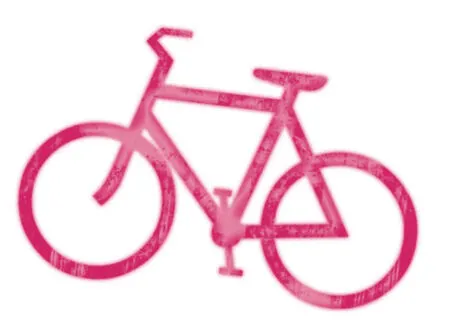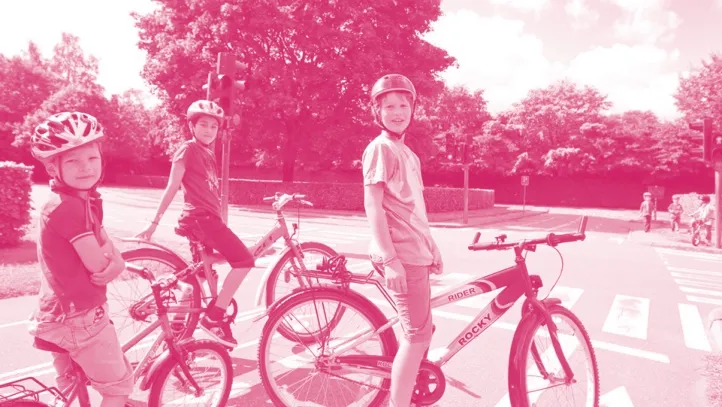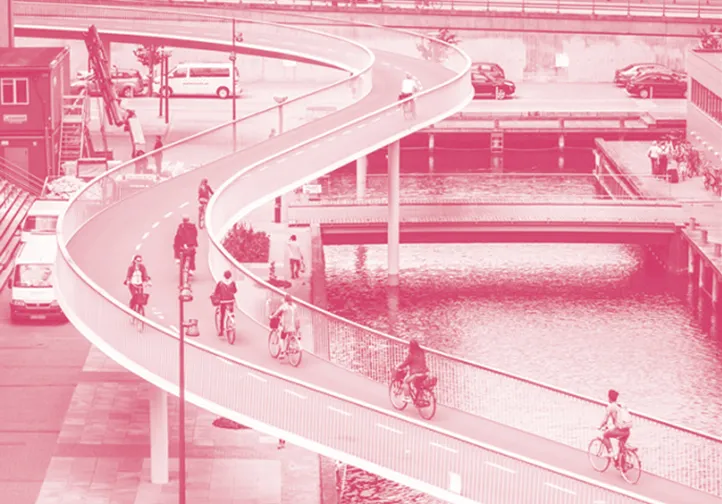Copenhagen’s Piles of Bicycles
文/埃伦·奥森 译/杨心彤
Copenhagen’s Piles of Bicycles
文/埃伦·奥森 译/杨心彤

Copenhagen is one of the best places in the world to be a cyclist but there is a downside—thousands of parked bicycles. Sometimes it gets out of control.
[2]In 2014, when Copenhagen got its Cykelslangen1Cykelslangen〈丹麦语〉指哥本哈根著名的蛇形自行车桥。它看似浮于水面,像一条橘黄色的长蛇横跨海港,不仅创造了更多的骑行空间,给骑行者带来便利,也成就了哥本哈根的一道靓丽风景。(Cycle Snake)—a new two-lane, bicycle-only bridge across its harbour—the city edged2edge渐渐移近。even closer to being a cyclists’ paradise.
It’s not the only bridge in the city designed for cyclists, but it got cyclists out of the way of sauntering pedestrians on a harbourfront, it wriggled3wriggle蜿蜒前进;蠕动而行。in a pleasing way and it looked great.
[3]The number of city dwellers who commute by bicycle is above 50%,and a recent survey suggests that even when you add in people who start their commute outside the city, 41% arrive at their place of work or study thanks to pedal power.
[4]There are in fact more bicycles in Copenhagen than people, five times as many bicycles as cars, and 400km of cycle lanes—not shared with cars or pedestrians—for a city of about 600,000 people.
[5]This has many obvious benefits,such as cleaner air and physical fi tness.If only more thought had gone into what happens when riders get off.
[6]Cycle parking is a shambles here.
Outside the main train stations, you could be forgiven for thinking there’d just been an accident. Piles of bicycles clustered4cluster聚集。around the racks look like they’ve been thrown down by someone on the run from the law.
[7]Elsewhere, bikes are often parked randomly on the pavement, taking up pedestrian space and blocking entrances to shops and restaurants. For many noncyclists, it’s a constant source of irritation.
[8]Niels Jarler, a non-cyclist in his 30s, says he often has to walk on the road to get to his fl at in central Copenhagen at weekends, the pavement is so cluttered5clutter乱堆放。. “It’s really infuriating,” he says. “Urban planners haven’t really thought properly about cycle parking at a local level.”
[9]Although theft is a risk, owners rarely chain their bikes to anything.Often they are just stacked6stack使成叠(或成摞、成堆)地放;使码放。one against another.
[10]While this may mean there is a low probability that your bike is the one that gets taken, untangling7untangle解开;理清。your trusty steed8steed可比作马的人(或车);坐骑。from the dense web often requires vast amounts of patience.
[11]Outside Copenhagen’s central train station, where people often leave their bike for the weekend, plenty of cyclists are fed up. “There just isn’t enough space,” says Kirsten Hoeholt, a ceramic artist.
[12]Another cyclist told me she had struggled to find a place for her bike.Equally, it can be tricky to find your machine amid the clusters, unless you remember exactly where you left it.
[13]While 95% of cyclists in the city are happy with conditions for cyclists overall, only 29% are satis fi ed with cycle-parking facilities—down from 40%in 1996.
According to Mikael Colville-Andersen, of the Copenhagenize Design Company9哥本哈根化设计公司,一家致力于为组织机构与城市提供自行车文化、相关产品设计与咨询服务的公司。, cycle parking is the “last great bastion” that cycling-friendly cities have yet to overcome.

[14]One of Copenhagen’s problems is that it has been growing rapidly.About 12,000 people are moving to the city each year, while only 7,000 new cycle parking spaces have been created over the last eight years.
[15]In the Dutch city of Groningen,the central train station has underground parking for 10,000 bikes, operated by a guard day and night.
In Utrecht10乌得勒支,荷兰中部城市。, a new cycle park over three floors at the central station has room for 4,300 bicycles—but it will soon be put in the shade by another facility to the east of the station, with room for 12,500.
[16]One Dutch idea on its way to Copenhagen is the removal of bikes that are parked illegally in congested areas.Leave your bike in the wrong place and you could fi nd that it has been moved to nearby bicycle racks.
[17]A few years ago “bike-butlers”were introduced in some areas. The butlers pick up bicycles that have been knocked over, pump air into flat tyres and give the bike-chains a bit of oil, to thank people for parking properly. ■
纵观全球,哥本哈根无疑是自行车出行的最佳地之一,但也存在一个缺点,成千上万的自行车停放在各处,有时会难以管理。
[2]2014年,哥本哈根建成了一条自行车高架路(蛇形自行车道)。新建的双车道高架桥仅允许自行车通行,横跨海港。车道的建成使得哥本哈根在成为骑行者天堂的道路上更进了一步。
它不是哥本哈根唯一一座专为骑行者设计的大桥,但可以让海边的骑行者与漫步者互不影响,各行其道。这条车道外形靓丽,曲折迂回又不失惬意。
[3]骑自行车通勤的城市居民占比超过了50%。最近的一项调查表明,即使算上从市外通勤到市内的人,骑车上班或上学的人也达41%。

蛇形车道
[4]事实上,哥本哈根的自行车比人还多,数量是汽车的5倍。这座人口约60万的城市拥有400公里的自行车道,此车道不与车辆和行人共享。
[5]自行车的普及有许多显而易见的好处,比如让空气更清洁、民众更健康。假如人们能重视自行车停放问题就更好了。
[6]在哥本哈根,自行车的停放可谓是混乱无序、一片狼藉。
主火车站外的情景如果让你认为那里刚发生了一场交通事故,也完全可以理解。成堆的自行车簇拥在停放架周围,看起来像是被潜逃的犯罪分子丢弃在那儿的。
[7]在其他地方,自行车也经常停放在人行道上,不仅占用行人的空间,还堵塞了商店和餐馆的入口。许多不骑车的人常常为此烦恼不已。
[8]30多岁的尼尔斯·贾里尔平时不骑自行车,说他为了周末回到自己在哥本哈根市中心的公寓,经常不得不走在马路上,因为人行道已经被堵死了。“真是令人恼火。”他抱怨道,“城市的规划者并没有妥善地考虑本地的自行车停放问题。”
[9]虽然存在盗窃这一潜在的风险,但车主们还是很少用锁链把自行车和某物拴在一起,通常只是和其他自行车码在一处。
[10]尽管这可能意味着你的自行车被小偷盯上的概率较低,但是,要想把你可靠的坐骑从密集的车堆中解放出来,往往需要巨大的耐心。
[11]周末,人们常常把自己的自行车停放在哥本哈根的中央火车站外面,让很多骑行者不胜其烦。“根本没有足够的空间。”陶艺家基尔斯滕·赫霍尔特说。
[12]另一名骑车的女士告诉我,她很难为自己的车找到一个停车位。同样地,在摆放密集的自行车堆里找到自己的车是很困难的,除非你准确地记得把它停在了哪儿。
[13]虽然哥本哈根95%的骑行者对骑行的总体条件感到满意,但人们对自行车停车设施的满意度已经从1996stack使成叠(或成摞、成堆)地放;使码放。年的40%下降到了29%。
就职于哥本哈根化设计公司的米卡埃尔·科尔维尔-安德森说,自行车停放问题是自行车友好城市尚未攻克的“最后的巨大堡垒”。
[14]城市规模的迅速扩大是哥本哈根所面临的问题之一。每年约有12000人移居到哥本哈根,而在过去的8年里,该市仅新增7000个停车位。
[15]荷兰格罗宁根市的中央火车站建有一座可容纳10000辆自行车的地下停车场,并且有人日夜看守。
在乌得勒支,坐落于中央车站的超三层新建自行车停车场可停放4300辆自行车,但很快它将被另一座位于车站东部的设施抢去风头,这座未建成的停车场有12500个停车位。
[16]哥本哈根正在考虑借鉴荷兰的一项举措,移走拥堵地区非法停放的自行车。如果乱停车,车就会被搬到附近的自行车架上。
[17]几年前,一些地区引进了“自行车管家”。管家会扶起被撞倒的自行车,帮没气的车胎打气,给自行车链条上一点油,以此来答谢按规矩停车的人。 □
哥本哈根“堆积成山”的自行车
ByEllen Otzen
(译者曾获第五届“《英语世界》杯”翻译大赛优秀奖)

